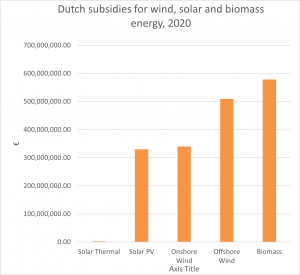 See below for an animation in Dutch about how biomass subsidies could be better spent in the Netherlands
See below for an animation in Dutch about how biomass subsidies could be better spent in the Netherlands
In 2020, the Netherlands spent around €579 million on subsidies for burning biomass – nearly all of it wood – in power and heat plants. If all the subsidies already awarded are paid out (including for new biomass plants not yet built or operating), this will go up to €800 million every year.
As a result of the subsidies, Dutch wood pellet imports, mostly from the Baltic States and the Southeastern USA, have been rising faster than those anywhere else in Europe. Dutch wood pellet imports are contributing to the destructive intensitve logging in highly biodiverse forests in both regions.
How could the current subsidies for biomass be better used?
Instead of subsidising high-carbon biomass burning, the Netherlands could significantly reduce its carbon emissions from the electricity sector by spending the same money on wind and solar power instead.
Our caluclations show that the €579 annual biomass subsidies right now could instead provide annual subsidies for any one of the following – or a combination of all three:
Onshore wind: 458 new wind turbines generating 2,119 Gigawatt hours of electricity a year
Offshore wind: 29 new wind turbines generating 883 Gigawatt hours of electricity a year
[Note that offshore wind turbines generate significantly more electricity than onshore wind turbines each.]
Rooftop solar PV: 262,234 houses with rooftop solar, providing 917 Gigawatt hours of electricity a year
Solar district heating plant: 593 Gigwatt hours of electricity a year.
How could the full subsidies already awarded for biomass be better used?
Onshore wind: 633 new wind turbines generating 2,930 Gigawatt hours of electricity a year
Offshore wind: 40 new wind turbines generating 1,221 Gigawatt hours of electricity a year
[Note that offshore wind turbines generate significantly more electricity than onshore wind turbines each.]
Rooftop solar PV: 362,621 houses with rooftop solar, providing 1,268 Gigawatt hours of electricity a year
Solar district heating plant: 820 Gigwatt hoors of electricity a year.
Please click here to see the assumptions and calculations used for the figures above.
